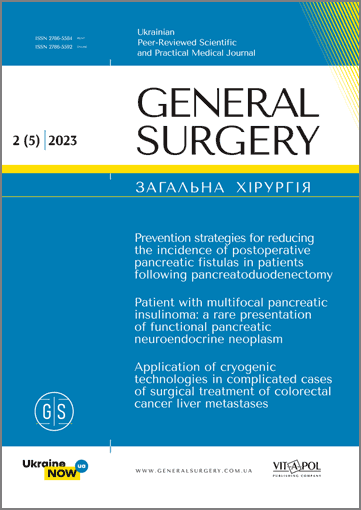Quantitative assessment of the breast implant malposition after augmentation mammaplasty
DOI:
https://doi.org/10.30978/GS-2023-2-47Keywords:
augmentation mammoplasty, diagnosis, malposition of implants, classificationAbstract
Slight displacement of breast implants from initial positioning is expected and inherent in submuscular augmentation mammoplasty (SAMP). However, due to various factors, displacement of implants can progress, causing discomfort, changes in the shape of the breast, and deterioration of aesthetics. The boundary between normality and pathology in the case of displacement of the mammary glands (MG) implants is currently unclear due to various reasons, including the lack of a quantitative measure of its assessment.
Objective — to develop a quantitative assessment of breast implant malposition (BIM) and to determine its one‑year frequency within a year after SAMP.
Materials and methods. The study included 112 women who underwent SAMP for hypomastia in the period from 2020 to 2022 at the Bogomolets National Medical University. The average age was 34.1±6.7 years, body mass index — 20.4±1.8 kg/m2; 78 (69.6%) women had a history of pregnancy and childbirth, and 75 (67.0%) were breastfeeding. Round prostheses with a smooth surface were implanted in all patients. The value of BIM was evaluated one year after SAMP according to the developed method as a percentage of the increase in the area of the non‑ossified area in relation to the area of the prosthesis.
Results. In all women, there was a 7.94.5% (from 1.5% to 34.5%) displacement of the implants from their initial location in all MG. Among the vectors of BIM, lower‑lateral ones prevailed — 124 (55.4%) MG compared to 53 (28.6%) upper‑lateral ones, p=0.001. Lower 18 (8.0%) and upper‑lateral at 150° — 11 (4.9%) BIM were the least common. Symmetrical matching of prosthesis movement vectors in both MGs was observed in 75 (67.0%) women; in 37 (33.0%), they were different. The same values of BIM in both MGs were observed in 54 (48.2%) women. In other cases, the values of BIM were greater in the right MG — 40 (35.7%) or in the left MG — 18 (16.1%). Cluster analysis classified the displacement of implants into 4 degrees: the first — from 1.5% to 6.4%, the second — from 6.5% to 10.4%, the third — from 10.5% to 20.0%, and the fourth >20.0%.
Conclusions. Using smooth‑surfaced, round implants, the displacement of all implants from their initial site was shown to be 7.9±4.5% one year following SAMP.
References
Mishalov SG, Khrapach VV, Markulan LYu, Khrapach OV, Zakhartseva OI. Rotation of mammary implants one year after the primary augmentic mammary plastic surgery. Хірургія України. 2018;(1):70-4. http://doi.org/10.30978/SU2018170. Ukrainian.
Brown MH, Somogyi RB, Aggarwal S. Secondary Breast Augmentation. Plast Reconstr Surg. 2016 Jul;138(1):119e-135e. doi: 10.1097/PRS.0000000000002280. PMID: 27348674.
Chopra K, Gowda AU, Kwon E, Eagan M, Grant SW. Techniques to repair implant malposition after breast augmentation: a review. Aesthet Surg J. 2016 Jun;36(6):660-71. http://doi.org/10.1093/asj/sjv261.
Denney BD, Cohn AB, Bosworth JW, Kumbla PA. Revision breast augmentation. Semin Plast Surg. 2021 May;35(2):98-109. http://doi.org/10.1055/s-0041-1727272.
Gabriel A, Maxwell G. Treatment of implant malposition. In: Managing Common and Uncommon Complications of Aesthetic Breast Surgery. Springer;2021. 250 p. ISBN: 978-3-030-57120-7.
Hahn M, Kuner RP, Scheler P, et al. Sonographic criteria for the confirmation of implant rotation and the development of an implant-capsule-interaction («interface») in anatomically formed textured breast implants with texturised Biocell-surface. Ultraschall Med. 2008;29(4):399-404. http://doi.org/10.1055/s-2007-963020.
Hidalgo DA, Spector JA. Breast augmentation. J Plast Reconstr Surg. 2014;133(4):567e-583e doi: 10.1097/PRS.0000000000000033.
Hidalgo DA. Breast augmentation: choosing the optimal incision, implant, and pocket plane. Plast Reconstr Surg. 2000 May;105(6):2202-16; discussion 2217-8. http://doi.org/10.1097/00006534-200005000-00047. PMID: 10839422.
ISAPS International survey on aesthetic/cosmetic procedures perfomed in 2021. www.isaps.org/media/vdpdanke/isaps-global-survey_2021.pdf.
Juan AN, Li YU. Advancement of complications related to augmentation mammoplasty using silicone gel prosthesis. Chinese Journal of Plastic and Reconstructive Surgery. 2020;2(1):51-8. https://doi.org/10.1016/S2096-6911(21)00009-1.
Maxwell GP, Van Natta BW, Bengtson BP, Murphy DK. Ten-year results from the Natrelle 410 anatomical form-stable silicone breast implant core study. Aesthet Surg J. 2015;35(02):145-55. http://doi.org/10.1093/asj/sju084.
Maxwell GP, Gabriel A. Non-cross-linked porcine acellular dermal matrix in revision breast surgery: long-term outcomes and safety with neopectoral pockets. Aesthet Surg J. 2014;34(4):551-9. http://doi.org/10.1177/1090820X14528207.
McGuire P, Reisman NR, Murphy DK. Risk factor analysis for capsular contracture, malposition, and late seroma in subjects receiving Natrelle 410 form-stable silicone breast implants. Plast Reconstr Surg. 2017;139(01):1-9. http://doi.org/10.1097/PRS.0000000000002837.
Montemurro P, Papas A, Hedén P. Is rotation a concern with anatomical breast implants? A statistical analysis of factors predisposing to rotation. Plast Reconstr Surg. 2017 Jun;139(6):1367-78. http://doi.org/10.1097/PRS.0000000000003387.
Munhoz AM, Marques Filho A, Ferrari O. Single-stage augmentation mastopexy with composite reverse inferior muscle sling technique for autologous reinforcement of the inferior pole: technical refinements and outcomes. Aesthet Surg J. 2020;40(6):356-73 DOI: 10.1093/asj/sjz334.
Namnoum JD, Largent J, Kaplan HM, Oefelein MG, Brown MH. Primary breast augmentation clinical trial outcomes stratified by surgical incision, anatomical placement and implant device type. J Plast Reconstr Aesthet Surg. 2013;66:1165-72. http://doi.org/10.1016/j.bjps.2013.04.046.
Spear SL, Little JWR. Breast capsulorrhaphy. Plast Reconstr Surg. 1988;81(2):274-9. http://doi.org/10.1097/00006534-198802000-00026.
Spear SL, Murphy DK, Slicton A, Walker PS; Inamed Silicone Breast Implant US. Study Group. Inamed silicone breast implant core study results at 6 years. Plast Reconstr Surg. 2007 Dec;120(7 Suppl 1):8S-16S. http://doi.org/10.1097/01.prs.0000286580.93214.df. PMID: 18090808.
Strasser EJ. An objective grading system for the evaluation of cosmetic surgical results. Plast Reconstr Surg. 1999 Dec;104(7):2282-5. http://doi.org/10.1097/00006534-199912000-00056.
Strasser EJ. Results of subglandular versus subpectoral augmentation over time: one surgeon’s observations Aesthet Surg J. 2006 Jan-Feb;26(1):45-50.
World Medical Association. World Medical Association Declaration of Helsinki: ethical principles for medical research involving human subjects. JAMA. 2013 Nov 27;310(20):2191-4. http://doi.org/10.1001/jama.2013.281053. PMID: 24141714.
Downloads
Published
How to Cite
Issue
Section
License
Copyright (c) 2023 Authors

This work is licensed under a Creative Commons Attribution-NoDerivatives 4.0 International License.






